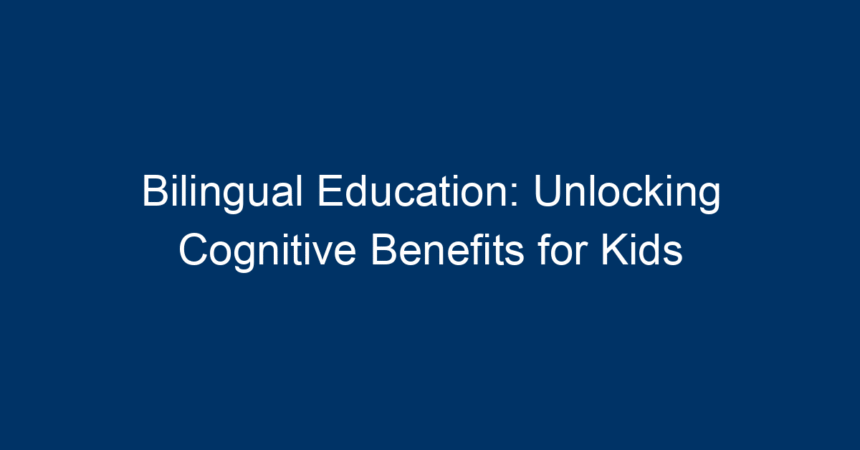In our rapidly intertwining world, the ability to communicate in multiple languages has never been more crucial. Bilingual education is not just a stepping stone toward fluency in another language; it’s a powerful tool that unlocks cognitive benefits for children, enhancing their learning experiences and future opportunities. In this article, we’ll explore the many advantages of bilingual education, delve into how it positively affects cognitive skills, and provide actionable insights for parents and educators alike.
What is Bilingual Education?
Bilingual education refers to instructional programs where two languages are used for teaching academic content. This approach can take several forms, including:
- Dual Language Programs: Both languages are used to teach core subjects, promoting proficiency in both languages among all students.
- Transitional Bilingual Education: Students are taught in their native language initially, with the goal of transitioning to English.
- Maintenance Bilingual Education: This aims to maintain and develop students’ native language skills while also teaching them English.
Regardless of the approach, the ultimate goal of bilingual education is to foster language skills while promoting cognitive development.
The Cognitive Benefits of Bilingual Education
Enhanced Executive Functioning
Bilingual education strengthens executive functioning skills, which include attention control, problem-solving, and cognitive flexibility. Bilingual children often excel in tasks that require multitasking and critical thinking. Studies have shown that speaking more than one language enhances a child’s ability to ignore irrelevant information and focus on what’s important.
Improved Memory and Information Retention
Learning a new language necessitates memorization of vocabulary, grammar rules, and pronunciations. This cognitive exercise strengthens the brain’s capacity for memory, allowing bilingual children to retain and retrieve information more effectively than their monolingual peers. The constant practice of shifting between languages also requires the use of working memory, improving overall cognitive resilience.
Greater Creativity and Problem-Solving Skills
Bilingual education promotes divergent thinking, a cognitive process that involves generating multiple solutions to a problem. Since bilingual individuals can approach problems from different linguistic and cultural perspectives, they are often more creative in their thinking and problem-solving abilities.
Social and Emotional Advantages
Greater Cultural Awareness and Sensitivity
Through bilingual education, children are exposed to diverse cultures, enhancing their understanding and appreciation for different perspectives. This cultural competence makes them more empathetic and socially aware, essential traits in a globally interconnected society.
Increased Confidence
Bilingual children often experience a boost in self-esteem as they master multiple languages and navigate varied cultural contexts. This newfound confidence can significantly influence their willingness to take on challenges in academic settings and beyond.
The Academic Advantages of Bilingual Education
Improved Academic Performance
Research indicates that children who participate in bilingual education often perform better academically in subjects beyond language arts. The cognitive skills gained from bilingualism translate to better analytical skills, reading comprehension, and overall academic performance.
Long-Term Educational Outcomes
Bilingual education not only enhances immediate academic performance but also leads to improved long-term educational outcomes. Bilingual students are often more likely to pursue higher education and attain advanced degrees. They also tend to have more career opportunities, as many employers prefer candidates who can communicate in multiple languages.
Implementing Bilingual Education: Strategies for Parents and Educators
Choosing the Right Program
When considering bilingual education, it’s vital to choose the right program suitable for your child’s age and learning style. Research different types of bilingual programs available in your area, such as dual language, immersion, or transitional bilingual education, to find the best fit.
Creating a Language-Rich Environment
Parents can facilitate bilingual learning at home by cultivating a language-rich environment. This can be done through:
- Literature: Providing books in both languages.
- Media: Encouraging children to watch films and listen to music in both languages.
- Conversations: Engaging children in conversations in both languages to reinforce their language skills.
Encouraging Peer Interaction
Social interaction is vital in language acquisition. Parents and educators can facilitate playdates or group activities with other bilingual children. This social exposure reinforces language use in natural settings, making learning more effective and enjoyable.
Consistency is Key
Consistency plays a critical role in language retention. Parents and educators should strive to provide regular and structured interactions in both languages, whether through routine conversations at home or during classroom activities.
Overcoming Challenges in Bilingual Education
Addressing Language Proficiency Issues
Some children may struggle with proficiency in one language or the other. To tackle this, parents and educators can focus on:
- Targeted Learning: Identify areas of weakness in either language and allocate specific time for improvement.
- Supplemental Resources: Use educational apps, games, and internet resources tailored to strengthen language skills.
Navigating Cultural Identity
Children growing up in bilingual environments may face challenges related to their cultural identity. It’s essential for parents and educators to discuss these issues openly, helping children to understand the value of their bilingualism and the importance of both cultures.
Conclusion: The Future of Bilingual Education
In our increasingly global world, bilingual education is a powerful tool that unlocks significant cognitive, social, and academic benefits for children. By fostering creativity, enhancing problem-solving skills, and promoting cultural awareness, bilingual education sets the foundation for children to succeed in diverse environments.
For parents and educators looking to implement bilingual education, focusing on creating a supportive, engaging, and language-rich environment can make all the difference. With careful planning and consistent effort, we can cultivate a generation of bilingual children who are not only proficient in multiple languages but also equipped with the cognitive tools necessary to thrive in today’s interconnected world.
Take action today! Explore bilingual education programs, foster rich linguistic experiences at home, and encourage cultural exchanges. The cognitive benefits of bilingual education are waiting to be unlocked!




